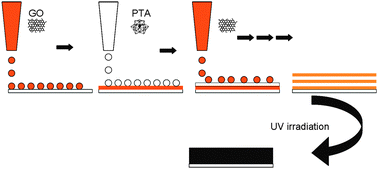Scientists in China have used graphene oxide and polyoxometalate solution as ink to fabricate a composite film with a photo printer.
The film shows a linear relationship between the coverage and number of printing cycles, which indicates a steady-state film growth. The team performed a proof-of-principle experiment on the application of the composite for electrochemical sensing and successfully detected dopamine, with increasing current response to increasing concentration. Dopamine is a neurotransmitter, levels of which are monitored to diagnose Parkinson’s disease.
Graphene films are used for transistors and sensors, and there is a need for efficient and facile strategies for large-scale fabrication; this method has potential in terms of reducing material waste, lower costs and scalability.
Read more about this exciting work in the full PCCP article:
Layer-by-layer inkjet printing of fabricating reduced graphene-polyoxometalate composite film for chemical sensors
Hui Zhang, Anjian Xie, Yuhua Shen, Lingguang Qiu and Xingyou Tian
DOI: 10.1039/C2CP41561E











